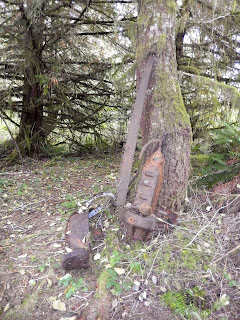 |
| Four klicks up Olsen Main from Powell Lake |
There's history all over the Powell River backcountry. Sliammon First Nation people have lived here for millennia.
Intrepid explorers such as
Vancouver and
Juan Francisco de la Bodega y Quadra followed in the late 1700s. Then came the traders and colonizers. Finally individuals, families and companies who were attracted to our natural resources including timber, fish, and water.
 |
| Take a left spur through a deep culvert. |
The
Powell River Paper Company built a pulp and paper mill at the mouth of the Powell River in the early 1900s.
A town was created for mill workers, and loggers branched out into the surrounding area to supply wood for the enterprise and to sell in Vancouver to support the burgeoning building industry. Entrepreneurial people followed forest workers into new areas to create farms to grow food for the new industries.
 |
| Olsen River 1/10th of a klick from homestead. |
On a recent quad ride, Wayne and I went to the site of an elaborate homestead in
Olsen Valley. This fertile area was once home to a cluster of families with elaborate houses and farms. The crops they produced were taken down to Olsen's Landing (the same spot where we offloaded our quads from the barge) and from there by boat to Powell River. The Olsen Valley community grew large enough to build their own school. Everyone thrived until 1955 when the mill diverted water from the Theodosia River into Olsen Lake to increase the flow into Powell Lake for power generation at the Powell River dam. The settlers left, and their abandoned homes were destroyed in 1972 to
discourage hippies from moving back to the land.
 |
| One of many rock retaining walls. |
Wayne stumbled onto the foundation of an elaborate homestead only four kilometres up from Olsen's Landing on a logging spur. It was evident he wasn't the first because the area had been cleared and arranged to make the historical site more visible. With my love of "treasures" he knew he had to take me there.
For more information about Olsen Valley, here are a few online resources you can check out.
Olsen Valley - Powell River Historical Museum
Olsen Valley Homestead - www.vanishinghistory.ca
Olsen Valley Homestead Layout Picture - www.vanishinghistory.ca
Olsen Valley by Dave Hurrie - www.vanishinghistory.ca
Olsen Valley Additional Pics of 1970s - www.vanishinghistory.ca
Olsen Valley by John - www.vanishinghistory.ca
Olsen's Landing - itsmysite.com
It's wonderful that people have left the artifacts in place so those of use who follow can imagine what life was like in this beautiful place. Here are a few of the highlights.
 |
| Items displayed on cement and rock foundation. |
 |
| Piping inside of foundation. |
 |
| Stairs leading down into the cellar area. |
 |
| Household items on display. |
 |
| Cement sidewalks around the home site. |
 |
| Cement stairs leading down to a level area. |
 |
| Old saw and equipment on display. |
 |
| Lots of old vehicle and equipment parts. |
There were so many things to see we will need to return. -- Margy
 Just about everywhere you go along roads in the Powell River backcountry you'll find Pearly Everlasting (Anaphalis margaritaea). It’s nice to have a flower that’s almost a namesake: Margy, Margaret, margaritaea.
Just about everywhere you go along roads in the Powell River backcountry you'll find Pearly Everlasting (Anaphalis margaritaea). It’s nice to have a flower that’s almost a namesake: Margy, Margaret, margaritaea. 





























































